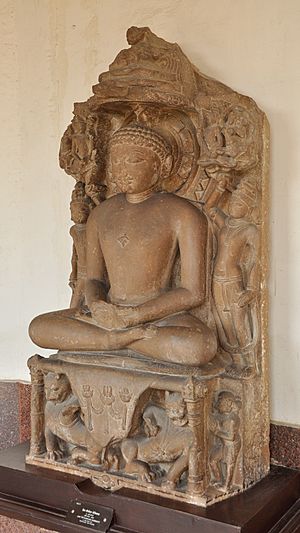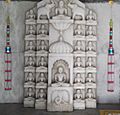Tirthankara facts for kids
In Jainism, a tirthankara (Sanskrit tīrthaṅkara) is an all knowing Teaching God who teaches the path to liberation from the cycle of births and deaths, called saṃsāra. According to Jains, over time, Jain teachings are gradually forgotten. Then, a rare individual is born who at some point in his life renounces the world to conquer the saṃsāra, the cycle of death and rebirth, on his own. After Tirthankara attains Kevala Jnana (omniscience) he refounds Jainism. Tirthankara provides a bridge for others to follow him from saṃsāra (worldy existence) to moksha (liberation).
According to Jains, exactly twenty-four tirthankaras grace this part of the universe in each half of the Jain time cycle. The first tirthankara was Rishabhanatha, who is said to have taught men various arts and professions including agriculture. The 24th and last tirthankara of present half-cycle was Mahavira (599-527 BC). His predecessor, Parshvanatha, the twenty-third tirthankara was a historical figure.
The teachings tirthankara are compiled as scriptures called Agamas. All tirthankaras teach same philosophy and ethics and their teachings do not contradict. While tirthankaras are worshiped by Jains, there grace is said to be available for all living beings, regardless of religious orientation.
Tirthankaras are called Jina (victor), which means one who has conquered inner enemies such as anger, attachment, pride and greed. They are entirely free of all passions, and personal likes and dislikes. After attaining omniscience, they are free from eighteen imperfections like hunger, thirst, sleep etc.
Contents
Tirthankara
The tīrthaṅkara nama-karma, a special type of karma is mentioned in the Jain texts. Bondage of this karma raises a soul to the supreme status of a Tīrthaṅkara. Tattvartha Sutra, a major Jain text, list down sixteen observances which lead to the influx of this karma-
Panch Kalyanaka
Five auspicious events called, Pañca kalyāṇaka happen in the life of every tirthankara:
- Gārbha kalyāṇaka (conception): When soul of the tirthankara comes into his mother's womb.
- Janma kalyāṇaka (birth): Birth of a tirthankara. Indra, the head of celestial beings performs a ritual on tirthankara on Mount Meru.
- Dīkṣā kalyāṇaka (renunciation): When a tirthankara renounces all worldly possessions and become an ascetic.
- Jñāna kalyāṇaka: The event when a tirthankara attains omniscience and becomes all knowing. After this celestial beings erect a divine preaching hall called samavasarana from where he delivers sermons.
- Nirvāṇa kalyāṇaka (liberation): When a tirthankara leaves his mortal body, it is known as nirvana. It is followed by the final liberation, moksha. Their soul goes to Siddhashila (topmost part of the Universe as per Jains) forever where they enjoy everlating happiness.
Samavasarana
After attaining omniscience, a tirthankara preaches the path to liberation in the samavasarana. According to Jain texts, the heavenly pavilion is erected by devas (heavenly beings) where devas, humans and animals assemble to hear the tirthankara. A tirthankara's speech is listened by all humans and animals in their own language. It is believed that during this speech, there is no unhappiness for miles around the site.
Tīrthaṅkaras of present cosmic age
Jainism teaches that time has no beginning or end. It moves like the wheel of a cart. Jains divide the time cycle in two halves, Utsarpiṇī or ascending time cycle and avasarpiṇī, the descending time cycle. 24 tirthankaras are born in each half of this cycle. In Jain tradition the tirthankaras were royal in their final lives, and Jain texts record details of their previous lives.
Twenty-one of the tirthankaras are said to have attained moksha in the kayotsarga (standing meditation posture), while Rishabhanatha, Neminatha and Mahavira are said to have attained moksha in the Padmasana (lotus position).
List of the 24 tirthankaras
Present cosmic age
In chronological order, the names, emblems and colours of the 24 tirthankaras of this age are mentioned below: Dhanuṣa means "bow" and hatha means "hands".
| No. | Name | Symbol | Colour | Height |
|---|---|---|---|---|
| 1 | Rishabhanatha (Adinatha) | Bull | Golden | 500 dhanuṣa |
| 2 | Ajitanatha | Elephant | Golden | 450 dhanuṣa |
| 3 | Sambhavanatha | Horse | Golden | 400 dhanuṣa |
| 4 | Abhinandananatha | Monkey | Golden | 350 dhanuṣa |
| 5 | Sumatinatha | Goose | Golden | 300 dhanuṣa |
| 6 | Padmaprabha | Padma | Red | 250 dhanuṣa |
| 7 | Suparshvanatha | Swastika | Golden | 200 dhanuṣa |
| 8 | Chandraprabha | Crescent Moon | White | 150 dhanuṣa |
| 9 | Pushpadanta | Crocodile or Makara | White | 100 dhanuṣa |
| 10 | Shitalanatha | Shrivatsa | Golden | 90 dhanuṣa |
| 11 | Shreyanasanatha | Rhinoceros | Golden | 80 dhanuṣa |
| 12 | Vasupujya | Buffalo | Red | 70 dhanusa |
| 13 | Vimalanatha | Boar | Golden | 60 dhanusa |
| 14 | Anantanatha | Porcupine according to the Digambara Falcon according to the Śvētāmbara |
Golden | 50 dhanuṣa |
| 15 | Dharmanatha | Vajra | Golden | 45 dhanuṣa |
| 16 | Shantinatha | Antelope or deer | Golden | 40 dhanuṣa |
| 17 | Kunthunatha | Goat | Golden | 35 dhanuṣa |
| 18 | Aranatha | Nandyavarta or fish | Golden | 30 dhanuṣa |
| 19 | Māllīnātha | Kalasha | Blue | 25 dhanuṣa |
| 20 | Munisuvrata | Tortoise | Black | 20 dhanuṣa |
| 21 | Naminatha | Blue lotus | Golden | 15 dhanuṣa |
| 22 | Neminatha | Shankha | Black | 10 dhanuṣa |
| 23 | Parshvanatha | Snake | Blue | 9 hatha |
| 24 | Mahavira | Lion | Golden | 4 hatha |
Images for kids
-
Jain chaumukha sculpture at LACMA, 6th century
-
Famous idol of Mahavir Swami at Shri Mahavirji
See also
 In Spanish: Tirthankara para niños
In Spanish: Tirthankara para niños












